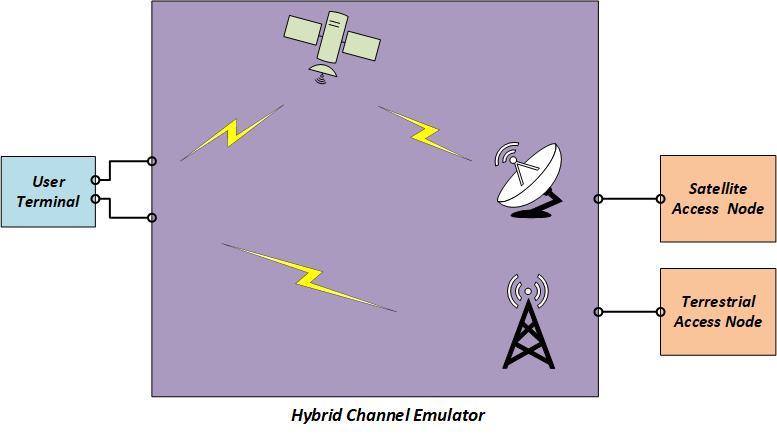-
StatusCompleted
-
Status date2025-04-16
-
Activity Code3B.045
The project objectives are the development and validation of a single solution capable of emulating the radio propagation conditions of two bi-directional 5G carriers (satellite-satellite or satellite-terrestrial). This has the twin challenges of providing an emulator that accurately models the dynamics, and tightly controls the channel impairments, of a wide variety of scenarios, and one that covers frequency bands spanning nearly 30 GHz.

Processing large bandwidths requires FPGAs with large resource capabilities. Efficient digital processing design is critical to minimize device FPGA costs.
Given the large bandwidths and wide range of frequencies being handled, the introduction of unintended signal distortion by the channel emulator is a challenge that requires careful design and built-in compensation techniques.
Synchronizing all elements of a 5G network to agree on timing and position of satellites and user equipment in high mobility scenarios.
The HCE is a new and unique product:
-
Highly integrated solution that does not require external applications to model the satellite orbits or generate time-series data for each impairment
-
Hardware support for up to 1 GHz of instantaneous bandwidth
-
Frequency-agile external RF interface equipment capable of interfacing not only at 3GPP FR1 and FR2 bands but also in Ku- and Ka satellite bands
-
Cost-effective multi-channel support for both satellite and terrestrial 5G channels in a single product
-
Hardware-in-the-loop testing of bi-directional 5G carriers for both satellite-satellite or satellite-terrestrial links
-
Realistic and accurate emulation of satellite and terrestrial link characteristics including: atmospheric effects (e.g. rain fade), Doppler, delay, and path loss variations, as well as impairments introduced by transmit and receive RF components, such as nonlinear distortion, phase noise, amplitude ripple, and thermal noise
-
Ability to model all forms of satellite constellations, including traditional geostationary satellites as well as MEO, LEO and HEO satellites or combinations thereof
-
Frequency-agile external RF interface equipment capable of interfacing not only at 3GPP FR1 and FR2 bands but also in Ku-and Ka satellite bands
-
Hardware support for up to 1 GHz of instantaneous bandwidth
-
Streaming satellite ephemeris data for real time satellite position updates to keep tight network synchronization
The proposed solution for the Hybrid Channel Emulator (HCE) is based on three components:
-
An enhanced version of SPCI’s RLS-2100 radio link simulator product.
-
An integrated multi-channel FR1 up and down-converter unit (FR1 UC/DC), which supports frequencies up to 7.125 GHz that cannot currently be supported internal to the RLS-2100.
-
A multi-channel FR2+ up and down-converter unit (FR2+ UC/DC), which supports frequencies in the mmWave band plus the satellite Ku/Ka-band frequencies.
There are two major development streams. The first stream includes the development of the IF version of the hybrid channel emulator (HCE) together with FR1 up/down converters (UC/DCs). The second stream is the development of FR2+ UC/DCs, where FR2+ is the 3GPP FR2 frequency band (up to 30 GHz) plus the Ku and Ka satellite bands. The outputs of the streams are integrated and tested to provide the final documentation, hardware and software.
A contract extension was granted to develop means for the RLS-2100 to provide ephemeris information to a gNodeB or intermediate entity such that 3GPP-defined messages SIB19 (SIB31) and SIB32, as appropriate, can be transmitted.
Project Milestones:
Preliminary Design Review – July 2021
Final Design Review – September 2021
Critical Design Review – January 2022
Test Readiness Review – June 2022
Project Extension (CCN) – June 2023
Final Review – November 2024
The project is complete, and the Hybrid Channel Emulator (HCE) is a commercialized product now, and in the hands of users.
The RLS-2100 Radio Link Simulator, a key component of the HCE, solution is a versatile hardware-in-the-loop tester, allowing users to efficiently test a wide range of terrestrial and non-terrestrial communication scenarios. When applied to 5G testing, the RLS-2100 provides industry leading capabilities, to verify end-to-end communication link performance in the lab.




